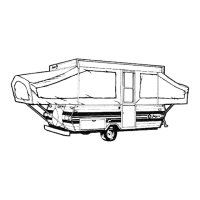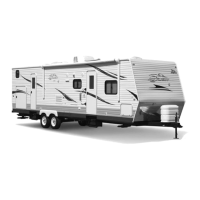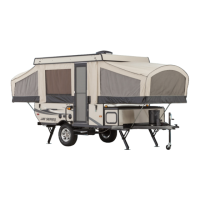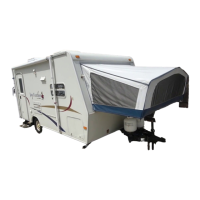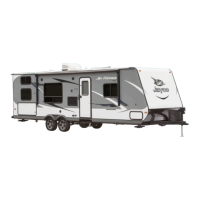SECTION 6
ELECTRICAL SYSTEM – 30 AMP
44
GFCI RECEPTACLE OUTLET
Grounding is your personal protection from
electrical shock. Your RV has a ground fault
current interrupter (GFCI) receptacle outlet
engineered into the 120-volt AC electrical
system. It may have additional outlets wired
through, and protected by, the GFCI. Its
function is to reduce possible injury caused by
electric shock. The GFCI will not protect
against short circuits or overloads.
Test all GFCI receptacles monthly
The 120-volt AC electrical system must be on
in order to test the GFCI.
1. Plug a 120-volt AC electrical device into
the GFCI receptacle outlet.
2. Push and release the RESET button (the
120-volt AC electrical device should
operate normally).
3. Push in the TEST button.
4. The RESET button should pop out
indicating the GFCI receptacle has been
“tripped” and
the 120-volt AC electrical
device should cease to operate.
5. Push in the RESET button again and it
should hold. If the GFCI did not trip, do not
use the GFCI receptacle outlet or those
wired to it. Call your dealer for repair
assistance if it does not hold and pops
back out. Any faulty equipment must be
repaired before your RV is used again.
Although your RV’s exterior power receptacle
(if so equipped) is not a GFCI receptacle
outlet, it is wired through and protected by the
interior GFCI.
CALCULATING ELECTRICAL LOAD
When you purchase and use 120-volt
appliances, remember your RV is limited to a
maximum load of 30 amps. When camping
and traveling, remember each appliance and
120-volt accessory places a load on the RV
electrical system. You may periodically trip a
circuit breaker if the combined load of these
appliances and accessories exceeds your 30
amp rating.
You can determine the amperage rating of an
appliance by dividing the watts used (usually
found on a label or plate affixed to the
appliance) by your RV’s supply voltage.
For example: 1200-watts divided by
120-volts AC equals 10-amps.
12-VOLT DC SYSTEM
The majority of your RV lighting is powered by
12-volt electricity. The 12-volt DC system is
composed of components that will operate
when the following conditions are met:
□ Power is supplied by the tow vehicle
alternator when the engine is running and
the 7-way trailer plug is connected. This
powers the RV’s running lights, brake
lights, turn signals and brakes.
In addition, the 7-way trailer plug provides
a common ground and a 12-volt charge
line to charge the auxiliary battery.
□ The converter will supply interior 12-volt
DC power when the power cord is plugged
into campground power. The converter will
also charge the auxiliary battery in most
situations.
□ The auxiliary battery powers many interior
12-volt components including the lighting
fixtures, water pump, 12-volt motors, 12-
volt appliances, etc. It also powers the
breakaway switch.
AUXILIARY BATTERY
(C
USTOMER SUPPLIED)
Your RV has many 12-volt DC loads. When
combined, their total is more than the
converter can produce. High demands for 12-
volt power can be met by an auxiliary battery
for limited periods of time. The 12-volt DC
electrical system is designed for usage with a
Group 27, deep cycle battery.
Dry camping
Consider the charge condition of the auxiliary
battery when dry camping. If the auxiliary
battery is not being recharged and power is
being drawn from it, it will eventually
discharge. A battery will discharge at a faster
rate as its energy level becomes depleted. It
is recommended you plan your electrical
usage accordingly. For accuracy, test the
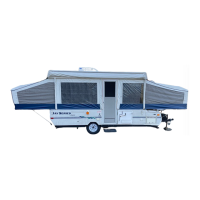
